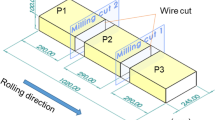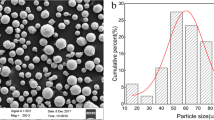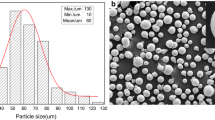Abstract
In recent years, additive-subtractive hybrid manufacturing (ASHM) technology has become a research hotspot. To realize high-precision manufacturing of complex parts and avoid machining interference, alternating additive manufacturing (AM) and subtractive manufacturing (SM) are valuable to be adopted. In this paper, a finite element numerical model was established to simulate the temperature history, stress distribution, and deformation trend of the thin-walled parts alternately fabricated by AM and milling process. Then, 316L stainless steel thin-walled samples were built by the alternating ASHM process. The molten pool temperature, the surface residual stress, and the surface contour of samples were measured and analyzed. The results show that high tensile stress is exhibited at the junction of the AM segment with the substrate or the previous SM segment. With the increase of deposition height, the tensile stress decreases first and then increases. After the subsequent milling, the surface residual stress level shows a decreasing trend, which is because the milling-induced compressive stress offsets the initial residual tensile stress. Moreover, the deformation of the two ends and the top of the AM segments is more significant than that of the bottom. After SM, the deformation in the top area of the SM segments is still slightly more extensive than the bottom area. The subsequent AM process results in a small increase in the residual stress of the milled segment, but had little effect on its surface deformation. Finally, the repeated cutting height between two segments was studied. Compared with the previous work, this strategy considers the effect of the alternating ASHM process on the residual stress and deformation of thin-walled parts. This study has certain guiding significance for the manufacture of thin-walled parts such as turbine blades and parts with internal structure by alternating ASHM process.





















Similar content being viewed by others
References
Yang YY, Gong YD, Qu SS, Xin B, Qi Y (2019) Additive/subtractive hybrid manufacturing of 316L stainless steel powder: densification, microhardness and residual stress. J Mech Sci Technol 33(12):5797–5807
Kistler NA, Corbin DJ, Nassar AR, Reutzel EW, Beese AM (2019) Effect of processing conditions on the microstructure, porosity, and mechanical properties of Ti-6Al-4V repair fabricated by directed energy deposition. J Mater Process Tech 264:172–181. https://doi.org/10.1016/j.jmatprotec.2018.08.041
Gao W, Zhang YB, Ramanujan D, Ramani K, Chen Y, Williams CB, Wang CL, Shin YC, Zhang S, Zavattieri PD (2015) The status, challenges, and future of additive manufacturing in engineering. CAD Comput Aided Des 69:65–89. https://doi.org/10.1016/j.cad.2015.04.001
Flynn JM, Shokrani A, Newman ST, Dhokia V (2016) Hybrid additive and subtractive machine tools-research and industrial developments. Int J Mach Tools Manuf 101:79–101
He Y, Wei JC, He YY, Rong XX, Guo WF, Wang F, Wang Y, Liu JY (2023) A process strategy planning of additive-subtractive hybrid manufacturing based multi-dimensional manufacturability evaluation of geometry feature. J Manuf Syst 67:296–314
He Y, Wei JC, Liu JY, Wang XJ, Wang Y, He L (2019) Experimental study on the fabrication profile and mechanical properties by substrate-inclined angle using laser melting deposition (LMD) integrating with the substrate of stainless steel. Opt Laser Technol 2020:125. https://doi.org/10.1016/j.optlastec.2019.106038
Le VT, Paris H, Mandil G (2017) Process planning for combined additive and subtractive manufacturing technologies in a remanufacturing context. J Manuf Syst 44:243–254. https://doi.org/10.1016/j.jmsy.2017.06.003
Le VT, Paris H, Mandil G (2018) The development of a strategy for direct part reuse using additive and subtractive manufacturing technologies. Addit Manuf 22:687–699. https://doi.org/10.1016/j.addma.2018.06.026
Zheng Y, Liu J, Ahmad R (2020) A cost-driven process planning method for hybrid additive-subtractive remanufacturing. J Manuf Syst 55:248–263. https://doi.org/10.1016/j.jmsy.2020.03.006
Chen L, Xu K, Tang K (2018) Optimized sequence planning for multi-axis hybrid machining of complex geometries. Comput Graph 70:176–187. https://doi.org/10.1016/j.cag.2017.07.018
Liu C, Li Y, Jiang S, Li Z, Xu K (2019) A sequence planning method for five-axis hybrid manufacturing of complex structural parts. P I Mech Eng B-J Eng. 1–10https://doi.org/10.1177/095440541988305
Cao DY, Malakooti S, Kulkarni VN, Ren Y, Lu H (2021) The effect of resin uptake on the flexural properties of compression molded sandwich composites. Wind Energy 25:71–93. https://doi.org/10.1002/we.2661
Cao DY, Malakooti S, Kulkarni VN, Ren Y, Lu H (2021) Nanoindentation measurement of core–skin interphase viscoelastic properties in a sandwich glass composite. Mech Time-Depend Mater 25:353–363. https://doi.org/10.1007/s11043-020-09448-y
Wang X, Xu T, Andrade M, Rampalli I, Cao DY, Haque M, Roy S, Baughman RH, Lu H (2021) The interfacial shear strength of carbon nanotube sheet modified carbon fiber composites. Mech Time-Depend Mater 2:25–32. https://doi.org/10.1007/978-3-030-59542-5_4
Yang YY, Gong YD, Qu SS, Rong YL, Sun Y, Cai M (2018) Densification, surface morphology, microstructure and mechanical properties of 316L fabricated by hybrid manufacturing. Int J Adv Manuf Tech 97(5–8):2687–2696. https://doi.org/10.1007/s00170-018-2144-1
Schoinochoritis B, Chantzis D, Salonitis K (2015) Simulation of metallic powder bed additive manufacturing processes with the finite element method: a critical review. P I Mrch Eng B-J Eng 231(1):96–117. https://doi.org/10.1177/0954405414567522
Li JN, Gao D, Lu Y, Hao ZP, Wang ZQ (2022) Mechanical properties and microstructure evolution of additive manufactured 316L stainless steel under dynamic loading. MSEA 855:143896.
Vasinonta A, Beuth JL, Griffith M (2007) Process maps for predicting residual stress and melt-pool size in the laser-based fabrication of thin-walled structures. J Manuf Sci Eng 129:101–109. https://doi.org/10.1115/1.2335852
Wang JD, Xue Y, Xu D, Zeng YZ, Li LQ, Wang ZQ, Jiang FC (2023) Effects of layer-by-layer ultrasonic impact treatment on microstructure and mechanical properties of 304 stainless steel manufactured by directed energy deposition. Addit Manuf 68. https://doi.org/10.1016/j.addma.2023.103523
Li B, Jiang X, Yang J, Liang SY (2015) Effects of depth of cut on the redistribution of residual stress and distortion during the milling of thin-walled part. J Mater Process Technol 216:223–233. https://doi.org/10.1016/j.jmatprotec.2014.09.016
Chen ZT, Yue CX, Xu YS, Liu XL, Liang SY (2023) An analytical machining deformation model of H-section multi-frame beam integral components. J Mater Process Tech 314:117907. https://doi.org/10.1016/j.jmatprotec.2023.117907
Yue CX, Zhang JT, Liu XL, Chen ZT, Liang SY, Wang LH (2022) Research progress on machining deformation of thin-walled parts in milling process. Acta Aeronaut Astronaut Sin 43(4):525164
Salonitis K, Alvise L, Schoinochoritis B, Chantzis D (2016) Additive manufacturing and post-processing simulation: laser cladding followed by high speed machining. Int J Adv Manuf Tech 85:2401–2411
Heigel JC, Phan TQ, Fox JC, Gnaupel-Herold TH (2018) Experimental investigation of residual stress and its impact in machining in hybrid additive/subtractive manufacturing. Procedia Manufacturing 26:929–940
Li PF, Gong YD, Wen XL, Xin B, Liu Y, Qu SS (2018) Surface residual stresses in additive/subtractive manufacturing and electrochemical corrosion. Int J Adv Manuf Tech 98:687–697. https://doi.org/10.1007/s00170-018-2283-4
Wu X, Zhu W, He Y (2021) Deformation prediction and experimental study of 316L stainless steel thin-walled parts processed by additive-subtractive hybrid manufacturing. Materials 14. https://doi.org/10.3390/ma14195582
Zhang S, Gong MM, Zheng XY, Gao M (2021) Residual stress and tensile anisotropy of hybrid wire arc additive-milling subtractive manufacturing. J Mater Process Tech 293:1170. https://doi.org/10.1016/j.jmatprotec.2021.117077
Yin J, Zhu H, Ke L, Lei W, Dai C, Zuo D (2012) Simulation of temperature distribution in single metallic powder layer for laser micro-sintering. Comput Mater Sci 52:333–339
Panda BK, Sarkar S, Nath AK (2020) 2D thermal model of laser cladding process of Inconel 718. Mater Today: Proc 41:286–291. https://doi.org/10.1016/j.matpr.2020.09.214
Funding
This work was supported by the National Natural Science Foundation of China (NSFC) under Contract Nos. 61571153 and 51173034, Self-planned Task of State Key Laboratory of Robotics and System (HIT), the Programme of Introducing Talents of Discipline of Universities (Grant No. B07108), Postdoctoral Innovation Talent Support Program of China (No. BX2021092), and JCJQ, 2022-JCJQ-JJ-0646.
Author information
Authors and Affiliations
Corresponding authors
Ethics declarations
Competing interest
The authors declare no competing interests.
Additional information
Publisher's Note
Springer Nature remains neutral with regard to jurisdictional claims in published maps and institutional affiliations.
Rights and permissions
Springer Nature or its licensor (e.g. a society or other partner) holds exclusive rights to this article under a publishing agreement with the author(s) or other rightsholder(s); author self-archiving of the accepted manuscript version of this article is solely governed by the terms of such publishing agreement and applicable law.
About this article
Cite this article
He, Y., Wei, J., Peng, Y. et al. Deformation prediction and experimental investigation on alternating additive-subtractive hybrid manufacturing of 316L stainless steel thin-walled parts. Int J Adv Manuf Technol 129, 5271–5285 (2023). https://doi.org/10.1007/s00170-023-12592-7
Received:
Accepted:
Published:
Issue Date:
DOI: https://doi.org/10.1007/s00170-023-12592-7




